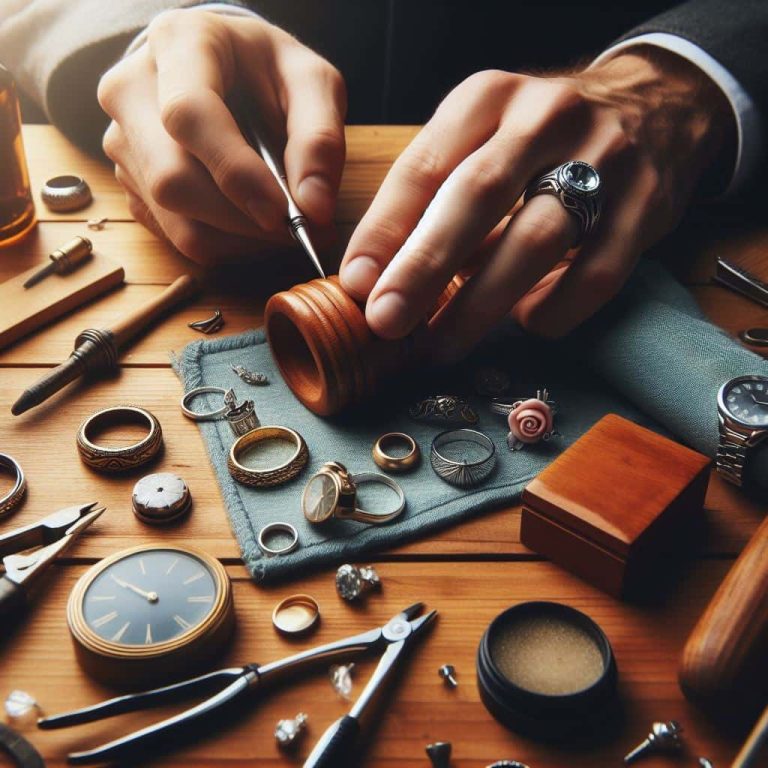Why Does Some Jewelry Turn Skin Green and 6 Tips To Avoid It
Whether it is a layering ring, a wedding band, or a fashion ring, there are probably many of you that wear them on a daily basis.
I know I do!
You leave your ring on for a long time and when you finally need to remove it, you see a dark green mark where the ring was.
Has that happened to you before?
Do you know what it is and how to remove this greenish-blue mark?
Today, I will be explaining why this happens, how to remove it from your skin, and a few tips on how to prevent this from happening.

Why Does Your Ring Turn Your Finger Green?
Here are 4 possible reasons why your finger turns green from your jewelry.
1. ABRASIVES
During the production of your jewelry, abrasives may be used to polish your ring.
If the abrasive was not removed before you wear your new ring, it could leave a mark on your finger.
You can remove the residual abrasive from your ring by giving it a quick clean before wearing it.
2. ACIDITY LEVEL OF YOUR BODY
The ring you borrowed from your sister turned your finger green, but it didn’t turn her finger green.
Metals react differently to the chemistry in our bodies.
Discolouration can be caused by the acidity levels in your body. The higher the acidity level, the more likely the metal will react with your skin.
3. PATINA
Metals created by synthesizing copper and zinc together causes a thin layer of “patina” when it is oxidized. When it is worn on your finger, the colour transfers over leaving a greenish stain.
4. COPPER OXIDE
As the name suggests, the stain is caused by the copper content in your jewelry.
Some rings and some jewelries are made from copper.
When you sweat, or wash your hands with your ring on, the liquid reacts with the copper creating copper oxide.
This results in a marked stain on your skin.
Is it Dangerous or Bad for You?
While the darkening of your skin can be very frightening, it actually has no adverse effect on your body.
There is no harmful effect on the body except that the fingers are coloured.
What Kind of Jewelry Turns Skin Green?

So, do all metals turn your skin green or only some?
What kind of metals turn your skin green?
We’ll explore different metal types in this section.
1. DOES COPPER TURN MY SKIN GREEN?
When you sweat, or wash your hands with your copper ring on, the liquid reacts with the copper creating copper oxide.
Copper can discolour and this discolouration can be transferred onto your skin.
2. DOES STERLING SILVER TURN MY SKIN GREEN?
Pure silver (99.9%) is highly malleable and since it is too soft to use in jewelry, other metals are introduced into the composition to give it strength and durability.
Sterling silver, also referred to as 925 silver, is composed of 92.5% silver. The remaining 7.5% is made up of other trace metal alloys to give the silver structure and rigidity.
For jewelry, the most widely-used silver alloy is sterling silver.
Sterling silver can cause discolouration depending on the composition of the residual 7.5% of this alloy.
If copper is present in your sterling silver jewelry, moisture can react with the copper creating copper oxide.
The discolouration in the jewelry formed by the copper can discolour and transfer onto your skin.
3. DOES 18K GOLD TURN MY SKIN GREEN?
Similar to silver, gold on its own will not tarnish or cause reactions to the skin.
However, also like silver, gold is extremely malleable in its purest 24K form.
Hence, 14K, 18K, and 22K designations are introduced:
14K: 14 parts gold and remaining 10 parts other materials
18K: 18 parts gold and remaining 6 parts other materials
22K: 22 parts gold and remaining 2 parts other materials
Depending on the metal used to create the residual components of the alloy, your gold jewelry can still turn your skin green.
How Can I Get Rid of the Colour?

You have been wearing your new ring for days. You finally remove your ring and to your disappointment, a large green stain where you ring was.
So, how can you get rid of this discolouration?
1. CLEAN YOUR SKIN
If you notice the stain starting to form, just remove your ring and wash your hands to remove this green mark.
However, the longer you wait, the more difficult it will be to remove the pigmentation.
2. SOAK IN WARM SOAPY WATER
Soak your hands in a bowl of warm soapy water. Gently scrub the affected area with a body sponge or a loofah. If you don’t notice the stain lightening or getting smaller, add a few drops of liquid soap onto your loofah and continue scrubbing.
3. WAIT FOR A FEW DAYS
If the mark does not disappear even after you have tried the above techniques, you will have to wait for your skin to regenerate. It will take a few days, but it will gradually disappear.
How Can I Avoid It?

Once serious pigmentation forms, it could be difficult to remove.
In this case, the only thing that can be done is to wait for new skin to generate.
This takes a few days but it will eventually disappear.
The best practice would be to implement these preventative measures to avoid this from happening in the very beginning.
1. KEEP YOUR SKIN DRY
Remove the ring during activities where you are likely to sweat. We recommend taking off your jewelry before vigorous exercises.
If you sweated while wearing your ring, remove and dry immediately.
The pH in your sweat will react with the metals in your ring to cause skin discolouration.
2. BAKING SODA PASTE
Keep your rings and jewelry clean. Cleaning your jewelry from residual polishing abrasives and patina, will prevent the transfer of colour onto your finger.
You can use a DIY baking soda paste.
Mix 1:1 baking soda and water until it is in a paste-like form.
Put the paste onto a soft cloth or cotton and polish the inside of your ring.
3. DO NOT GET WET
Remove your ring and jewelry from any water-related activities.
Metals don’t mix well with liquids.
It’s a good habit to keep in mind when taking care of your valuable jewelry.
Remove your jewelry before showering and swimming. If your jewelry has already been in contact with water, dry well with a cloth before putting it back on.
4. STORE IT PROPERLY
Storing your jewelry properly in a dry and dark environment away from elements will keep your jewelry from reacting with air and moisture – key elements that will quickly tarnish your jewelry.
The worst possible place to store jewelry is on a jewelry stand in the bathroom.
The moisture and steam from your bathroom will cause your jewelry to tarnish extremely quickly.
5. DO NOT WEAR IT AT THE BEACH
Limited exposure to water for cleaning purposes, followed by immediate drying with a cloth is actually recommended for any types of jewelry.
Water, by itself, is not what causes tarnishing and rapid oxidation in your jewelry, but it is the chemicals found in the water.
Salt content in seawater will accelerate the rate of tarnishing.
6. APPLY NAIL POLISH
You can prevent your jewelry from directly contacting your skin with a thin coat of clear nail polish.
Apply a thin layer of varnish in the inside of your ring and allow it to dry completely before you put it back on.
The Verdict
There is a high chance of staining your fingers with cheap costume jewelry.
But, fine jewelry like sterling silver and 18K gold can also turn your skin green depending on many factors like the makeup of your jewelry and your body’s chemistry.
It’s important to learn how to care for your jewelry so that you can avoid turning your fingers green the next time you wear your sterling silver ring.
Now that you know how to properly care for your jewelry, are you ready to take a look at our affordable high quality jewelry pieces to add to your collection?







